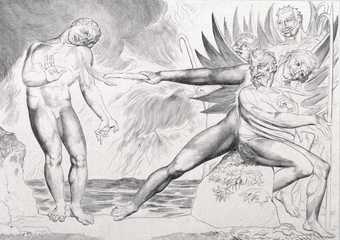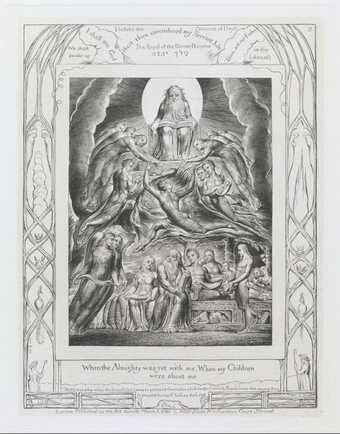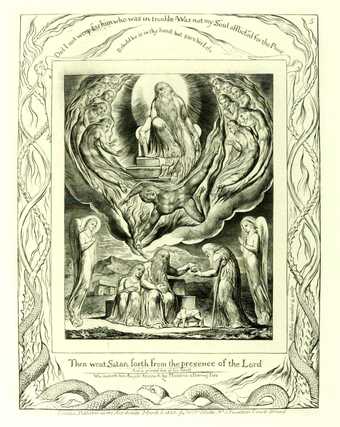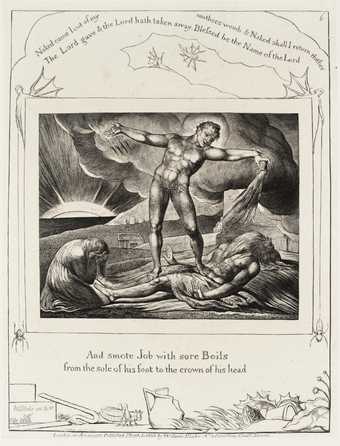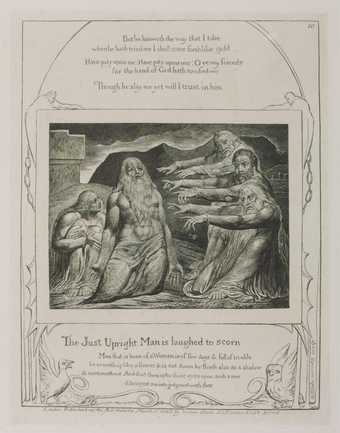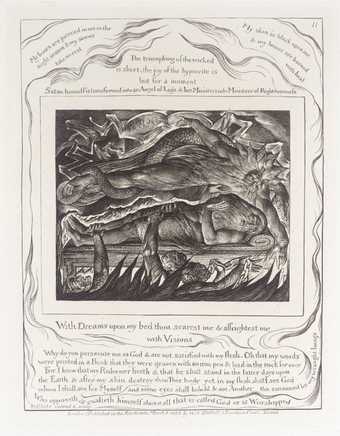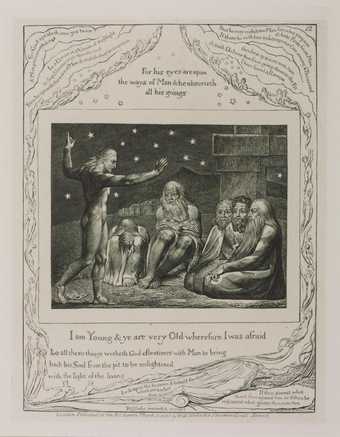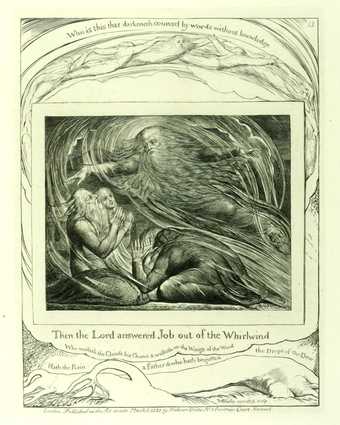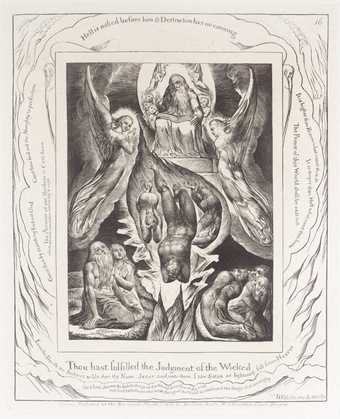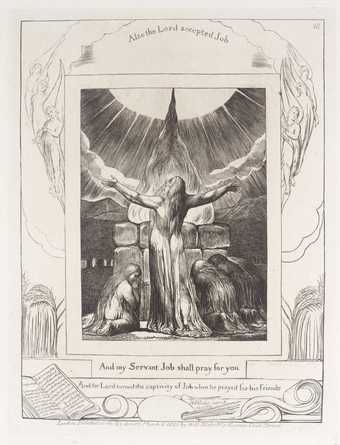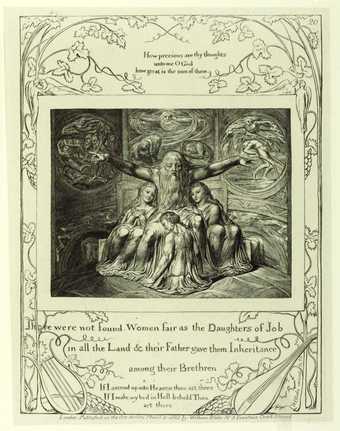
In Tate Britain
Prints and Drawings Room
View by appointment- Artist
- William Blake 1757–1827
- Medium
- Line engraving on paper
- Dimensions
- Image: 197 × 153 mm
- Collection
- Tate
- Acquisition
- Purchased with the assistance of a special grant from the National Gallery and donations from the Art Fund, Lord Duveen and others, and presented through the Art Fund 1919
- Reference
- A00014
Catalogue entry
A00014 [from] Illustrations to The Book of Job: Engravings
1823–6/1874 [A00012-A00032; T05845; complete]
A 00012–32 /-
Twenty-two line engravings on india paper laid on drawing paper approx. 510×345 (20×13 1/2)
Purchased with the assistance of a special grant from the National Gallery and donations from the National Art-Collections Fund, Lord Duveen and others, and presented through the National Art-Collections Fund 1919
PROVENANCE John Linnell; his heirs, sold Christie's 15 March 1918 (183) £33.12.0.bt Martin for the donors
LITERATURE Gilchrist 1863, 1, pp.283–4, 297; Wicksteed 1910 and 1924; Russell Engravings 1912, 102–15 no.33: Keynes Bibliography 1921, pp.179–82 no.55: Binyon and Keynes 1935, series repr. vol.VI; Keynes Engravings 1950, pp.16–17, series repr.pls. 42–68; Keynes Writings 1957, pp.869–70, 872, 874, 876–7; S. Foster Damon, Blake's Job 1966, series repr.; Bentley Blake Records 1969, pp.234 n.i, 277–397 passim, 586–605; Andrew Wright Blake's Job: A Commentary 1972, series repr.; Lindberg 1973, pp.24–32, 40–52, 167–76, 183–352 nos.0A–21A, series repr.; Bentley Blake Books 1977, pp.517–24 no.421; Bindman Graphic Works 1978, pp.486–7 nos.625–46, series repr.; Mitchell 1978, pp.41–2; Essick Printmaker 1981, pp.92, 105, 220, 234–50, 252; Robert N. Essick, ‘Blake's Engravings to the Book of Job; An Essay on their Graphic Form with a Catalogue of their States and Printings’ in David Bindman, ed., William Blake's Illustrations of the Book of Job 1987, pp.35–101.
John Linnell, who had commissioned the second set of watercolour illustrations to the Book of Job in 1821, entered into a formal agreement with Blake for the engravings on 25 March 1823: Linnell was to pay Blake £5 a plate or £100 for the set, and in addition he agreed to give Blake an extra £100 if the profits of the work made this possible. The agreement was for twenty engravings though in the event twenty-one subjects were engraved together with a title-page. On 5 March 1825 Linnell went with Blake to the printer J. Lahee to see proofs being taken. The series is dated 8 March 1825 but the final engravings do not seem actually to have been ready until the end of March 1826 (Bentley 1969, pp.277, 300 and 327). At this time 215 sets of engravings marked ‘Proof’ were issued; these should be distinguished from the working proofs, on some of which Blake tried out designs for the borders. The word ‘Proof’ was then deleted (traces can be seen on A00013) and a further 100 sets were printed on drawing paper. According to John Linnell Jr, writing to Bernard Quaritch on 6 May 1892, Linnell, after the 1826 printing, ‘put the plates away, & they were never again used after this time until the year 1874. At this time my father...had one hundred copies printed from the plates upon India paper’. Although the distinctive cover is now missing, it seems that the Tate Gallery's copies of the engravings are from this 1874 printing. The original plates were given by Herbert Linnell to the British Museum Print Room on 28 May 1919.
Each engraving is inscribed ‘W Blake inv. & sculp’. In addition each is inscribed in the lower margin with variations of the text ‘London. Published as the Act directs March 8:1825 by William Blake No3 Fountain Court Strand’; the first actual design (A00012) is mistakenly dated with the year 1828 and ‘Willm’ is sometimes substituted for ‘William’, while the punctuation is also slightly varied.
More importantly, the borders of each design bear a number of inscriptions taken from the Bible or with variations of biblical texts. These add a verbal gloss to the designs which in themselves embody Blake's critical reaction to the original story as set out in the Old Testament. The fullest analysis is in Lindberg though Wicksteed, Damon 1966 and Wright also contain full commentaries. Blake's interpretation of his text is only given in summary form in this catalogue.
These engravings were formerly inventoried as nos.3372 i–xxii. The new inventory numbers omit the title-page.
A00014 Job's Sons and Daughters Overwhelmed by Satan
Line engraving 197×153 (7 7/8×6); platemark 219×170 (8 5/8×6 11/16)
Inscribed ‘WBlake inven: &: sculp’ b.r., ‘London. Published as the Act directs March 8: 1825 by Willm Blake No3 Fountain Court Strand’ below, ‘3’ t.r., and with texts given below
Illustration no.3: Job, i, 13, 18–19. Blake gives this design a long descriptive title from Job, i, 18–19: ‘Thy Sons and thy Daughters were eating & drinking Wine in their eldest Brothers house & behold there came a great wind from the Wilderness & smote upon the four faces of the house & it fell upon the young Men and they are Dead’. At the top is written ‘The Fire of God is fallen from Heaven’ (Job, i, 16) and ‘And the Lord said unto Satan Behold All that he hath is in thy Power’ (Job, i, 12).
Here the figure of Satan, unlike the previous design, is shown in traditional horrific guise with large bat-like wings. The somewhat strange placing of Satan's feet is one of the stronger arguments for Wicksteed's theory of Blake's left- and right-hand symbolism; Satan's left-hand foot is placed forward denoting evil. The placing of the feet also relates to those of the central figure below, whose pose, as Lindberg has shown, is based on an Antique pathos formula, exemplified by the Laocoön, the subject of three drawings and a famous engraving by Blake (Butlin 1981, nos.679–81, repr.pls.898, 898A and 899, and, for the engraving, Bindman
Graphic Works 1978, no.623 repr. and Essick Separate Plates 1983, no.xix, pls.51–3). The upside-down figure in the pose of the crucified on the right may allude to Blake's comment that ‘The Modern Church Crucifies Christ with the Head Downwards’ (A Vision of the Last Judgment
1810; Keynes Writings 1957, p.615).
Published in:
Martin Butlin, William Blake 1757-1827, Tate Gallery Collections, V, London 1990
Explore
- architecture(30,960)
- ruins(3,711)
-
- residential(213)
- universal concepts(6,387)
-
- destruction(383)
- actions: expressive(2,622)
-
- rescuing(21)
- arm / arms raised(839)
- crouching(276)
- falling(90)
- man(10,453)
- group(4,227)
- male(959)
- Bible: Old Testament(381)
- Satan(36)
- birth to death(1,472)
-
- death(685)
- inscriptions(6,664)
-
- caption(358)
- printed text(1,138)
- quotation(297)
You might like
-
William Blake Ciampolo the Barrator Tormented by the Devils
1826–7, reprinted 1892 -
William Blake Satan before the Throne of God
1825, reprinted 1874 -
William Blake Satan Going Forth from the Presence of the Lord, and Job’s Charity
1825, reprinted 1874 -
William Blake Satan Smiting Job with Sore Boils
1825, reprinted 1874 -
William Blake Job’s Despair
1825, reprinted 1874 -
William Blake Job Rebuked by his Friends
1825, reprinted 1874 -
William Blake Job’s Evil Dreams
1825, reprinted 1874 -
William Blake The Wrath of Elihu
1825, reprinted 1874 -
William Blake The Lord Answering Job out of the Whirlwind
1825, reprinted 1874 -
William Blake Behemoth and Leviathan
1825, reprinted 1874 -
William Blake The Fall of Satan
1825, reprinted 1874 -
William Blake The Vision of Christ
1825, reprinted 1874 -
William Blake Job’s Sacrifice
1825, reprinted 1874 -
William Blake Job and his Daughters
1825, reprinted 1874 -
William Blake Ciampolo the Barrator Tormented by the Devils
1826–7, reprinted 1968

